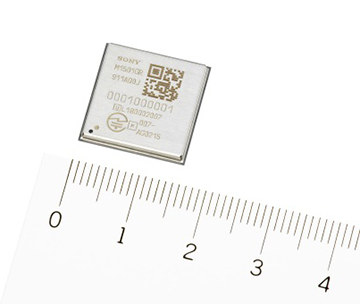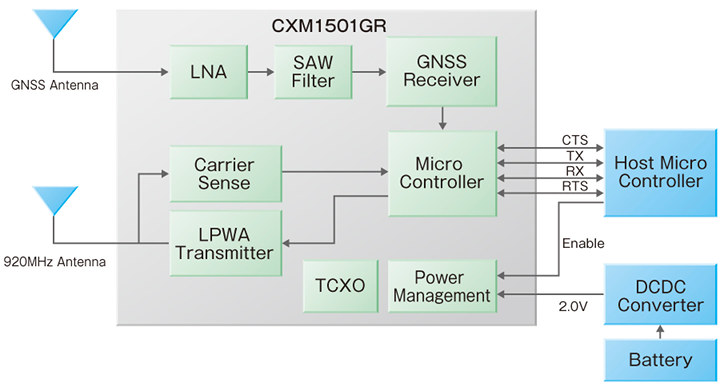 While there are many LPWAN (Low Power Wide Area Network) standards, three appear to dominate the news namely LoRaWAN, SigFox, and 3GPP NB-IoT/eMTC. They all offer long range and up to 10-year of battery life enabled by the use of low bitrate which is fast enough to send sensor data.
While there are many LPWAN (Low Power Wide Area Network) standards, three appear to dominate the news namely LoRaWAN, SigFox, and 3GPP NB-IoT/eMTC. They all offer long range and up to 10-year of battery life enabled by the use of low bitrate which is fast enough to send sensor data.
We can now add another LWPAN standard to the list, as Sony has developed ELTRES wireless communication standard suitable for IoT networks, and announced their CXM1501GR ELTRES module with a range of over 100km, even while traveling at 100km/h.
Key features and specifications:
- ELTRES Connectivity
- Antenna radiated power – 20mW
- Communication direction – Uplink only
- Frequency – 923.6 MHz to 928.0 MHz (23-channel frequency hopping)
- Main modulation system – π/2 Shift BPSK
- Sub-modulation system – Linear chirp modulation
- Transmission system – Four repeated transmissions of 0.4 sec or shorter packets
- Reduction of interference with other systems – CSMA (Carrier Sense Multiple Access)
- Error correction code – LDPC (Low Density Parity Check) code
- Effective rate – Number of transmission bits / total transmission time
80 bps (Channel rate: 6.35 kbps) - Reception sensitivity – -142dBm
- GNSS – High-sensitivity, low-power GNSS LSI for compatibility with GPS, GLONASS, and QZSS
- Host Interface – UART
- Security function – Included
- Voltage – 2.0V
- Dimensions – 16 x 16 x 2.0 mm
- Package – 65-pin LGA (0.5mm pitch)
- Certification – Radio Act of Japan (007-AG0043)
 Some quick remarks. ELTRES is basically using the same frequency bands as LoRa radios, and it is uplink only, meaning ELTRES nodes can send data, but cannot be controlled remotely. Although we know it’s supposed to run on a coin cell battery, Sony has not provided any power consumption numbers for the module. ELTRES IoT network service will first be deployed in Japan starting this autumn with the eventual goal of providing national coverage. It’s unclear whether ELTRES will make it outside of Japan.
Some quick remarks. ELTRES is basically using the same frequency bands as LoRa radios, and it is uplink only, meaning ELTRES nodes can send data, but cannot be controlled remotely. Although we know it’s supposed to run on a coin cell battery, Sony has not provided any power consumption numbers for the module. ELTRES IoT network service will first be deployed in Japan starting this autumn with the eventual goal of providing national coverage. It’s unclear whether ELTRES will make it outside of Japan.
ELTRES wireless standard can be used for all sort of monitoring & tracking applications including bicycle rentals, landslides reports, yacht race tracking, location monitoring of drones and so on.
More details can be found in the module page, as well as ELTRES’ official website.

Jean-Luc started CNX Software in 2010 as a part-time endeavor, before quitting his job as a software engineering manager, and starting to write daily news, and reviews full time later in 2011.
Support CNX Software! Donate via cryptocurrencies, become a Patron on Patreon, or purchase goods on Amazon or Aliexpress




